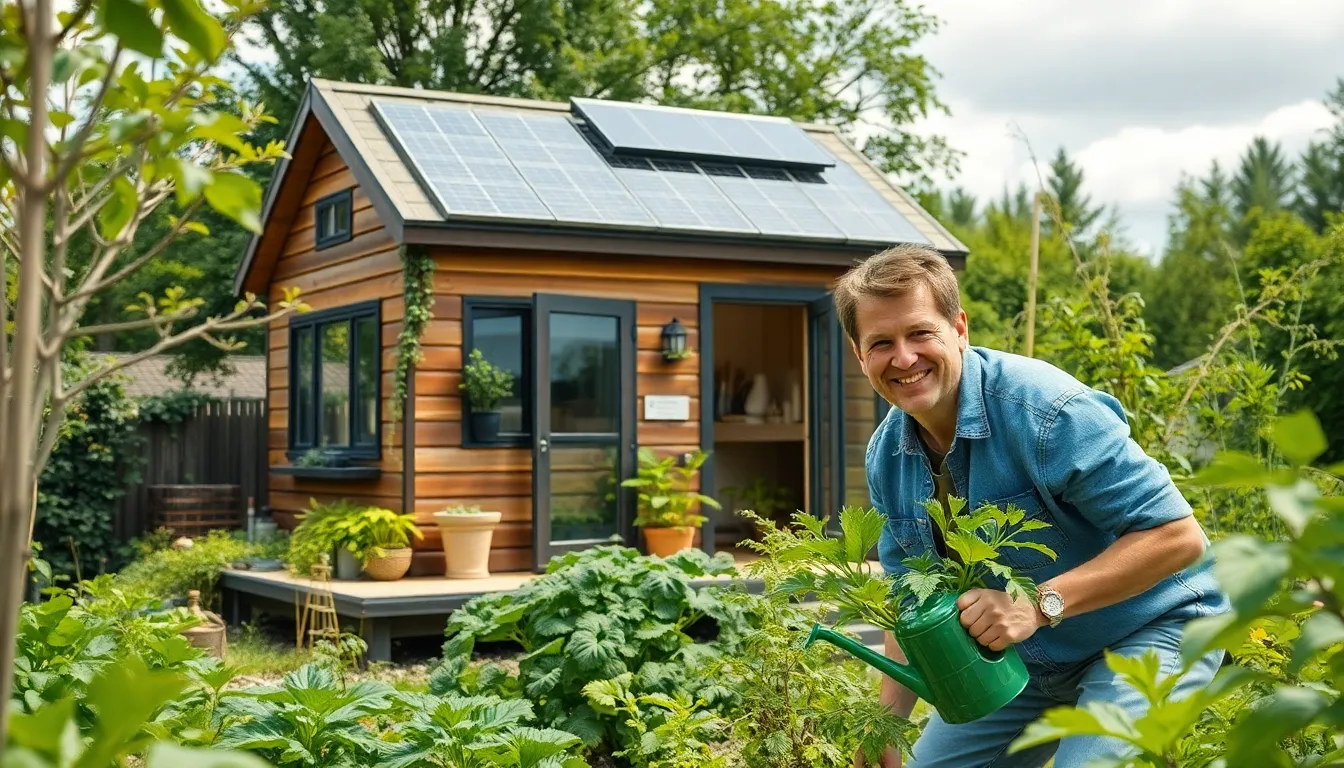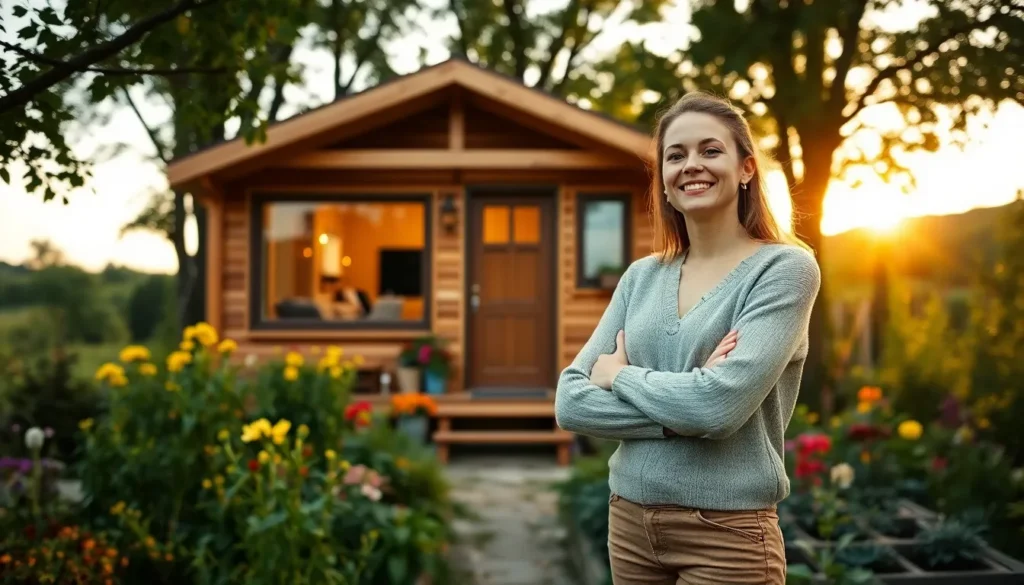Table of Contents
ToggleTiny homes are taking the world by storm, proving that good things really do come in small packages. Imagine living in a space that’s not just cozy but also eco-friendly and budget-friendly. These pint-sized palaces offer freedom from the clutter of traditional living, allowing people to downsize their possessions and upsize their happiness.
What Are Tiny Homes?
Tiny homes refer to compact living spaces that typically range from 100 to 400 square feet. These structures prioritize efficiency and functionality while promoting a minimalist lifestyle. Many tiny homes feature innovative designs that optimize limited space, allowing for separate areas for cooking, sleeping, and living.
Individuals often choose tiny homes for their affordability. The average cost of a tiny home is around $30,000 to $50,000, which is significantly lower than traditional homes. Many owners appreciate reduced utility bills and maintenance costs. Energy-efficient materials and appliances enhance sustainability, making tiny homes eco-friendly options.
Communities dedicated to tiny homes are emerging across the United States. These neighborhoods foster a sense of community and connection among residents while encouraging shared values of sustainability and simplicity. Some tiny homes are built on wheels, offering mobility and flexibility for owners seeking to travel or relocate.
People often customize tiny homes to reflect their personalities and lifestyles. Design choices may include lofted sleeping areas, foldable furniture, and smart storage solutions. The trend towards tiny homes appeals to those looking to downsize possessions and cultivate a more fulfilling life.
More than just a housing choice, tiny homes represent a movement towards sustainable living. Environmental benefits arise from smaller spaces that require fewer resources to build and operate. Choosing a tiny home significantly reduces an individual’s carbon footprint while promoting a deliberate lifestyle centered around necessity rather than excess.
Benefits of Tiny Homes

Tiny homes offer numerous advantages that appeal to various individuals and families. Their eco-friendly design and affordability contribute to their increasing popularity.
Environmental Impact
Tiny homes significantly reduce carbon footprints, promoting sustainable living. With smaller living spaces, they consume less energy for heating, cooling, and lighting. Many tiny homes utilize energy-efficient appliances, further decreasing energy use. Studies indicate that these homes produce fewer waste materials during construction and maintenance. Additionally, they often feature sustainable materials, such as reclaimed wood, which minimizes environmental harm. Gardening opportunities often accompany tiny home living, encouraging residents to grow their own food and contribute positively to local ecosystems.
Financial Savings
Financial savings play a crucial role in the appeal of tiny homes. Average costs range from $30,000 to $50,000, which is considerably lower than traditional homes. Lower mortgage payments lead to reduced financial stress, enabling individuals to allocate funds to other priorities. Utility bills also decrease due to smaller space requirements, with many residents reporting savings of 30% or more. Insurance costs tend to be lower, further reducing overall expenses. Maintenance costs are generally lower as well, allowing for easier upkeep without significant investment.
Challenges of Tiny Homes
Tiny homes present distinct challenges despite their numerous advantages. Understanding these hurdles helps potential owners make informed decisions.
Space Limitations
Space limitations pose significant challenges for tiny home inhabitants. With an average size between 100 and 400 square feet, residents must strategically utilize every inch. Storage solutions like built-in shelves and multipurpose furniture become essential. Moreover, living in a compact area often requires prioritizing essential possessions. Flexibility is crucial as individuals adapt to a minimalist lifestyle. This adjustment can be difficult for people accustomed to larger living spaces. Common frustrations include cramped quarters and limited room for activities.
Zoning Regulations
Zoning regulations create obstacles for tiny home enthusiasts. Many areas have strict building codes that regulate the size and placement of homes. Compliance can become complex, depending on local laws. It’s vital to research zoning laws before committing to a tiny home. Property owners may encounter restrictions on land use or limitations regarding mobile homes. Not all locations permit tiny homes, which might restrict options in urban settings. Residents often need to navigate permitting processes that can be time-consuming. Understanding these regulations enables future tiny home owners to avoid potential legal complications.
Designing a Tiny Home
Designing a tiny home requires careful consideration of both functionality and personal style. Essential features must reflect the occupant’s needs and preferences.
Key Features to Consider
Prioritize durability in materials, as tiny homes experience significant wear. Select energy-efficient appliances to reduce utility costs while maintaining a modern lifestyle. Incorporate natural lighting through strategically placed windows, enhancing the home’s ambiance and reducing electricity usage. Consider versatile furniture, which serves multiple purposes, and can help maximize limited space. Optimize storage solutions by utilizing vertical space and built-in options to maintain a clutter-free environment. Each feature contributes to a cohesive design focusing on comfort and practicality, allowing tiny homeowners to thrive.
Maximizing Space Effectively
Crafting an efficient layout plays a crucial role in maximizing space within a tiny home. Embrace open floor plans to create a sense of spaciousness, enabling seamless movement between areas. Use multipurpose items, such as foldable tables and convertible sofas, to adapt spaces as needed. Explore creative storage under beds and couches, which can hide away seasonal items or extra supplies. Integrate outdoor living areas, like decks or patios, allowing residents to extend their functional space. Adopt these strategies to ensure every square foot serves a purpose, promoting a harmonious living experience in a compact environment.
Popular Tiny Home Models
Many popular tiny home models capture interest with their unique designs and functionality. The Tumbleweed Tiny House, known for its customizable options and charm, offers various floor plans ranging from 100 to 400 square feet. Its efficient layouts make it a favorite among tiny home enthusiasts looking for personalization.
The Escape Traveler, another popular model, features a travel-friendly design. Weighing around 3,000 pounds, it’s easy to tow while retaining a spacious interior. Highlighted by large windows, this model promotes natural lighting, enhancing the overall living experience.
Tiny Heirloom, renowned for luxurious tiny homes, combines style with efficiency. These homes often include high-end finishes, making them more appealing to buyers seeking upscale features in smaller spaces. Model prices typically start around $50,000 and can go significantly higher.
Lumbec, designed for simplicity, focuses on maximizing space effectively. Each unit includes built-in storage and multipurpose furniture to accommodate minimalist lifestyles. This model invites residents to embrace efficient living without sacrificing comfort.
The Kanga Room Systems model stands out with its innovative modular designs. Their flexibility allows homeowners to combine units for a larger living area if desired. These systems cater to diverse needs, whether for primary residences or vacation getaways.
Bungalow 20 embodies the essence of tiny homes with a modern rustic aesthetic. Pioneering energy-efficient materials, it aligns with the sustainability goals many tiny homeowners prioritize. Customized features frequently lead to a unique living atmosphere that resonates with individual styles.
Each of these models showcases the variety and innovation within the tiny home market, offering solutions for those drawn to smaller living spaces.
Tiny homes are more than just a trend; they represent a shift towards a more sustainable and fulfilling way of living. By embracing minimalism and efficiency, individuals can enjoy financial freedom while reducing their environmental impact. The unique designs and customizable features of tiny homes cater to diverse lifestyles, making them an appealing choice for many.
Despite the challenges of limited space and zoning regulations, the benefits of tiny home living often outweigh the drawbacks. As communities grow and support for this lifestyle increases, tiny homes are set to play a significant role in shaping the future of housing. Those considering this lifestyle can look forward to a simpler and more connected way of life.





